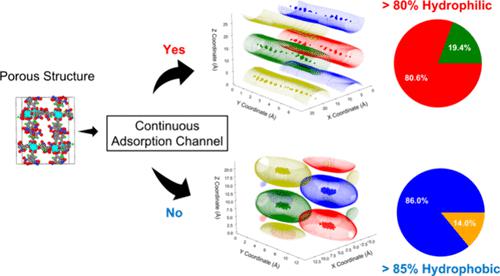当前位置:
X-MOL 学术
›
ACS Appl. Mater. Interfaces
›
论文详情
Our official English website, www.x-mol.net, welcomes your
feedback! (Note: you will need to create a separate account there.)
Connectivity Analysis of Adsorption Sites in Metal–Organic Frameworks for Facilitated Water Adsorption
ACS Applied Materials & Interfaces ( IF 8.3 ) Pub Date : 2023-09-27 , DOI: 10.1021/acsami.3c10710
Zhi-Xun Xu, Yi-Ming Wang, Li-Chiang Lin
ACS Applied Materials & Interfaces ( IF 8.3 ) Pub Date : 2023-09-27 , DOI: 10.1021/acsami.3c10710
Zhi-Xun Xu, Yi-Ming Wang, Li-Chiang Lin

|
Metal–organic frameworks (MOFs) have recently drawn considerable attention as promising adsorbents to harvest atmospheric water. To achieve an efficient harvesting process, seeking MOFs that demonstrate sharp condensation behavior is the key. Given that the clustering of water molecules in MOFs should be driven by not only MOF–water interactions but also water–water interactions, the spatial arrangement of water adsorption sites in a MOF is therefore crucial. Specifically, this study demonstrates the critical role of continuous adsorption channels (CACs) in MOFs. Such CACs will enable water molecules to stay in proximity and in a continuous manner, thus promoting the formation of hydrogen bonds and, consequently, the clustering of water molecules. We have developed an automatic algorithm to detect CACs based on the energy grid of host–guest interactions and applied the algorithm to more than 2000 diverse structures. The results show that more than 80% of the studied MOFs displaying water condensation at 298 K and 20% relative humidity predicted by Monte Carlo simulations indeed have CACs. The developments herein are anticipated to largely facilitate the future discovery of optimal adsorbents for water harvesting or water-adsorption-related applications in general. A Python-based code for detecting CACs in porous materials is also provided along with this article to employ this approach.
中文翻译:

促进水吸附的金属有机框架中吸附位点的连通性分析
金属有机框架(MOF)作为有前景的大气水吸附剂最近引起了人们的广泛关注。为了实现高效的收获过程,寻找表现出尖锐凝结行为的 MOF 是关键。鉴于MOF中水分子的聚集不仅由MOF-水相互作用驱动,而且还由水-水相互作用驱动,因此MOF中水吸附位点的空间排列至关重要。具体来说,这项研究证明了 MOF 中连续吸附通道 (CAC) 的关键作用。这种 CAC 将使水分子能够以连续的方式保持靠近,从而促进氢键的形成,从而促进水分子的聚集。我们开发了一种基于主客体相互作用的能量网格来检测 CAC 的自动算法,并将该算法应用于 2000 多种不同的结构。结果表明,蒙特卡洛模拟预测,在 298 K 和 20% 相对湿度下显示水凝结的所研究的 MOF 中,超过 80% 确实具有 CAC。预计本文的进展将极大地促进未来对水收集或水吸附相关应用的最佳吸附剂的发现。本文还提供了基于 Python 的代码,用于检测多孔材料中的 CAC,以采用这种方法。
更新日期:2023-09-27
中文翻译:

促进水吸附的金属有机框架中吸附位点的连通性分析
金属有机框架(MOF)作为有前景的大气水吸附剂最近引起了人们的广泛关注。为了实现高效的收获过程,寻找表现出尖锐凝结行为的 MOF 是关键。鉴于MOF中水分子的聚集不仅由MOF-水相互作用驱动,而且还由水-水相互作用驱动,因此MOF中水吸附位点的空间排列至关重要。具体来说,这项研究证明了 MOF 中连续吸附通道 (CAC) 的关键作用。这种 CAC 将使水分子能够以连续的方式保持靠近,从而促进氢键的形成,从而促进水分子的聚集。我们开发了一种基于主客体相互作用的能量网格来检测 CAC 的自动算法,并将该算法应用于 2000 多种不同的结构。结果表明,蒙特卡洛模拟预测,在 298 K 和 20% 相对湿度下显示水凝结的所研究的 MOF 中,超过 80% 确实具有 CAC。预计本文的进展将极大地促进未来对水收集或水吸附相关应用的最佳吸附剂的发现。本文还提供了基于 Python 的代码,用于检测多孔材料中的 CAC,以采用这种方法。































 京公网安备 11010802027423号
京公网安备 11010802027423号